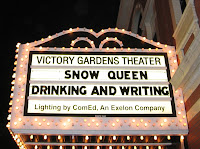
At any rate, here is the tale of one of my recent drinking-related adventures (still gotta find time for those). At the book signing last week (see Dec 7 post), we met two very fun guys named Sean Benjamin and Steve Mosqueda. They run the Drinking & Writing group, exploring the connection between alcohol and creativity. They put on a live, interactive theatre experience right now called Drinking & Writing Vol. 4, The Twelve Steps of Christmas. So of course we had to go check it out on Friday night.
 The show takes place at the Victory Garden Theater, next to the bar, and it starts around 10:30 pm. The bar is open, and drinking is encouraged. Steve and Sean drink beer, tell stories from their own holiday experiences, and talk about famous writers (with a focus on those who were known to drink). The show begins with a brief history of Paganism and Saturnalia, and the later development of Christmas. Sean and Steve even name their three wise men of drinking & writing, Charles Dickens, Frank Capra (for his movies) and Theodore Geisel (aka Dr. Seuss).
The show takes place at the Victory Garden Theater, next to the bar, and it starts around 10:30 pm. The bar is open, and drinking is encouraged. Steve and Sean drink beer, tell stories from their own holiday experiences, and talk about famous writers (with a focus on those who were known to drink). The show begins with a brief history of Paganism and Saturnalia, and the later development of Christmas. Sean and Steve even name their three wise men of drinking & writing, Charles Dickens, Frank Capra (for his movies) and Theodore Geisel (aka Dr. Seuss).Before the show, we met up at the Red Lion Pub across the street. We had some great pub grub, and I tried some new (to me) Scotches. I tried three different labels from the Cadenhead distillery, including
- Girvan Single Grain (very light in flavor, smooth for its proof, and sweeter than the others)
- 150th Anniversary Bottling of Single Malt (very nice, rich but balanced flavor, just a bit peaty and smoky)
- And a 15-year old single malt that for which I neglected to write down the details (given that it was my 3rd drink, and all of these were cask strength, I have forgiven myself for that one). Too bad, since that one was my favorite. It was well structured, smooth and complex. Guess I'll have to go back to the Red Lion.



































